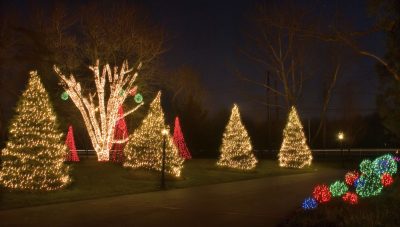LED Christmas Lights: An Incandescent vs LED Grudge Match
Understanding the Differences Between Incandescent and LED Christmas Lights
Once upon a time - and not so terribly long ago - candles ruled the roost when it came to decorative Christmas lighting. Candles, in fact, we're the go-to choice for many centuries simply because they were essentially the only practical choice.
But then an invention by one Thomas Alva Edison changed the Christmas lighting landscape. That invention, of course, was the incandescent light bulb.
Incandescent bulbs offered many advantages over candles - not the least of which was a radical reduction in the number of homes razed by candle-initiated fires each Christmas season. Incandescent lights were easier to use than candles, provided far more decorative options in terms of colors and styles, and were suited for outdoor displays. And so incandescent bulbs supplanted candles as the new go-to source for decorative Christmas lighting.
But once again there's a new kid on the block; an upstart challenger to the long-reigning king of Christmas lighting…
LED Lights Are Exploding in Popularity
LED technology has been around for a number of decades, but it’s only been in the past 10 years that it has moved into the LED Christmas lighting field. This latest generation LED technology has finally dethroned the incandescent. LEDs are a radical departure from Edison's incandescent light. While incandescent bulbs generate light by running an electrical current through a filament and setting it aglow, LEDs generate light by using electricity to excite light-emitting diodes.
They are radically different technologies. And the benefits offered by LEDs are almost as significant as the benefits that incandescents provided over candles.
Here's how incandescents and LEDs compare in a few critical areas:
-
Service Life
Incandescent bulbs are essentially designed to self-destruct. Running an electrical current through a filament eventually degrades the filament to the point of destruction.
But LED technology is much more durable and long-lasting. While service life estimates for most incandescent bulbs are in the hundreds of hours, service life estimates for LED bulbs are commonly in the tens of thousands of hours. Most LED bulbs are rated for a service life somewhere in the range of 25,000 to 75,000 hours.
-
Energy Efficiency
The differences in technology between incandescent and LED bulbs also greatly impact the amount of energy each requires. The old fashioned technique of zapping a filament with electricity is an inefficient method of generating light. The LED method of using electricity to excite diodes is extremely energy efficient. How much? LEDs use up to 90% less energy than comparable incandescents.
-
Cool vs Hot
All of that energy that incandescent bulbs waste? It's released in the form of heat. That's why grabbing an incandescent bulb that's on can elicit a yelp and raise a blister. But since LEDs aren't wasting energy, they remain cool to the touch, even after they've been on for hours. If you're using LED lights, no need to worry about pets, children, or foliage being burned by blistering-hot bulbs.
-
True Colors
Incandescent lights are available in many different colors, right? Wrong. To be technically precise, incandescents are available in only one color: the natural whitish glow of the electricity burn on the filament. To achieve different colors, the natural whitish color of incandescents is 'dyed' by covering the filaments with colored bulbs. And while that method of achieving different colors certainly works to a degree, the colors aren't truly pure.
But LEDs generate colors quite differently because the diodes of LED bulbs generate different colors on the color spectrum. Blue LED lights, for example, generate true blue on the wavelength spectrum - not a white light dyed blue with a colored bulb.
Does it really matter? If you want your Christmas display to offer the richest, brightest colors - then yes, it matters. (Do a side-by-side comparison of equivalent colors, and the difference between incandescents and LEDs will be quite apparent.)
Not Much of a Contest…
While LED lights truly are superior to incandescents in almost every way, incandescents do appear to win in one area: price. On average, incandescent bulbs are cheaper than the equivalent in LED bulbs. But a deeper comparison will reveal that LEDs win that battle, too. That's because the energy-savings and greater service life of LEDs combine to make them the less costly option over time.
Just as incandescent lights supplanted candles roughly a century ago, LEDs are gradually but surely replacing incandescents. It's a natural progression - superior technology replacing older, less advanced technology. It happens with great regularity with most of the products we use on a daily basis, things like computers, cell phones, televisions, etc.
So in a sense, it's rather strange that incandescent technology ruled for more than a hundred years. But that reign is indisputably drawing to a close.








